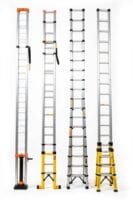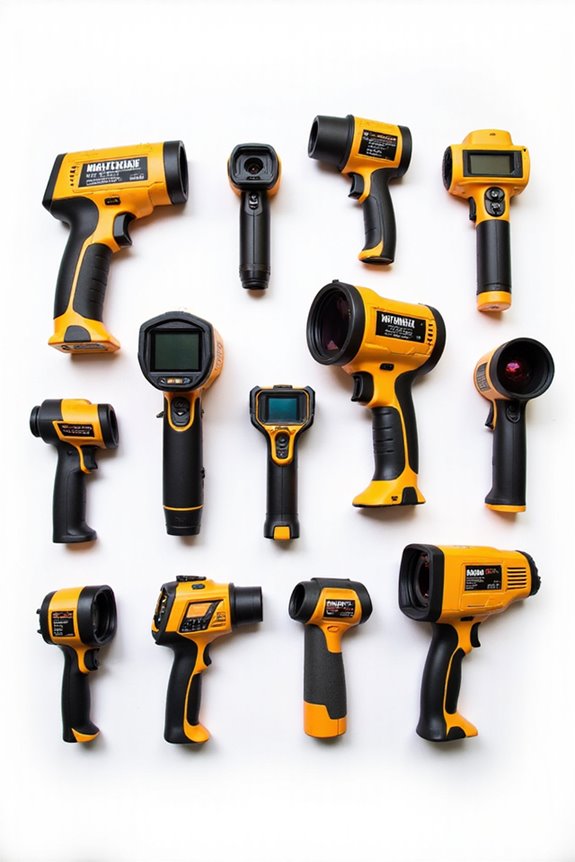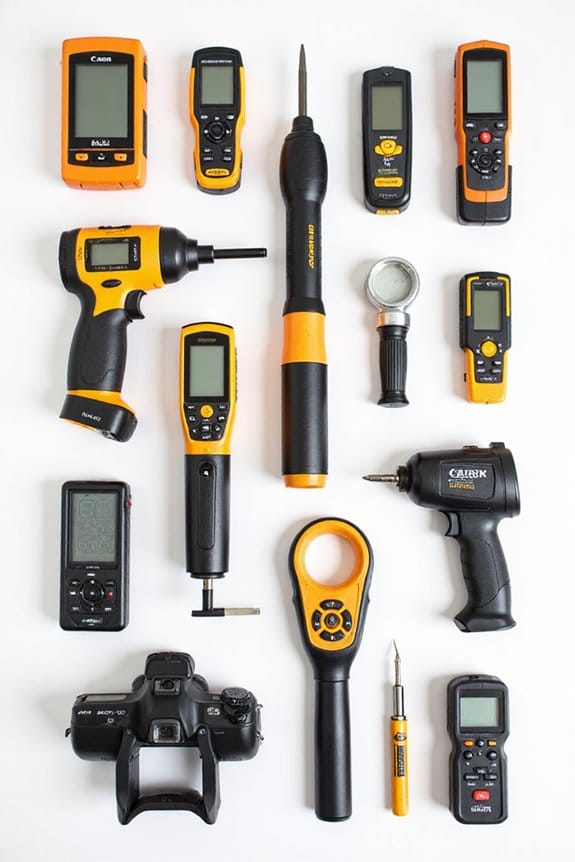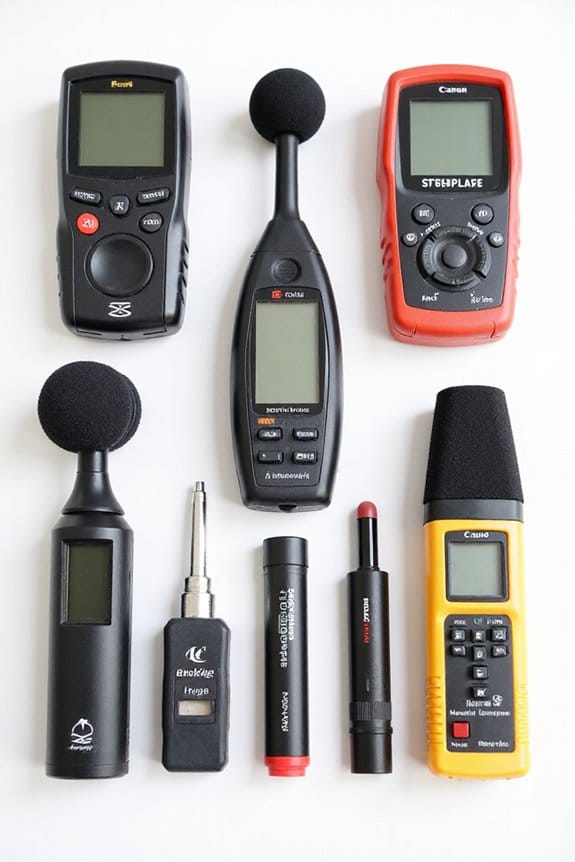As an Amazon Associate, we earn from qualifying purchases. Some links may be affiliate links at no extra cost to you. Although our opinions are based on curated research, we haven't used these products. Articles generated with AI.

10 Best Vibration Analysis Equipment of 2025 – Essential Tools for Predictive Maintenance
If you’re on the hunt for the 10 best vibration analysis tools in 2025, you won’t want to miss these essentials: 1) Handheld vibration meters for easy portability, 2) The Walfront LCD Digital Handheld Vibration Meter (AS63B) for accuracy and user-friendliness, and 3) The advanced WTVB01-BT50 Smart Vibration Module for flexible monitoring. These tools guarantee reliable predictive maintenance, helping your machinery run smoothly. Want to learn more about choices that suit your needs? Stick around!
Key Takeaways
- The Handheld Vibration Meter offers user-friendly features, measuring acceleration, velocity, and displacement, ideal for technicians in predictive maintenance.
- Walfront LCD Digital Handheld Vibration Meter (AS63B) provides accurate readings across various industries, making it a versatile choice for predictive maintenance applications.
- Digital Vibration Meter VM-6320 is ISO compliant and covers a wide frequency range, suitable for on-site vibration analysis and predictive maintenance.
- WTVB01-BT50 Smart Vibration Module enables remote monitoring via Bluetooth, enhancing machinery health tracking for predictive maintenance strategies.
- Comprehensive Vibration Analysis Certification Exam Preparation Packages equip professionals with essential knowledge, ensuring they are prepared for predictive maintenance challenges.
Rotating Machinery Reliability for Technicians and Engineers
Sale
Rotating Machinery Reliability for Technicians and Engineers
- Ron Brook, W. (Author)
- English (Publication Language)
- 400 Pages - 11/21/2022 (Publication Date) - Industrial Press, Inc. (Publisher)
When it comes to “Vibration Analysis Equipment of 2025,” it’s tailor-made for technicians and engineers who want to elevate their skills in rotating machinery reliability. This book offers key insights you can’t afford to ignore:
- Informative Content: It dives deep into complex topics, making even experienced pros nod in agreement.
- Real-Life Applications: You’ll find hundreds of practical examples that enhance your understanding.
- Author’s Expertise: Written by a respected figure in the field, you’ll appreciate his hands-on experience.
- Comprehensive Coverage: It’s got everything from averages to sample rates, ensuring you grasp vibration analysis fully.
Best For: Technicians and engineers seeking to enhance their skills and knowledge in rotating machinery reliability through practical insights and comprehensive coverage of vibration analysis.
Pros:
- Highly informative content that simplifies complex topics, making it accessible for professionals with varying levels of experience.
- Emphasis on real-life applications with hundreds of practical examples, enhancing understanding and engagement.
- Authored by a respected expert in the field, providing credibility and valuable insights drawn from decades of hands-on experience.
Cons:
- The depth of information may be overwhelming for beginners unfamiliar with the subject matter.
- Some readers may find the price point to be on the higher side for a technical book.
- Limited focus on topics outside of vibration analysis, which may not cater to all aspects of rotating machinery reliability.
Handheld Vibration Meter, Digital Vibration Analyzer
Handheld Vibration Meter,Digital Vibration Analyzer with LCD Backlight Display, USB Interface...
- Digital vibration meter has a large LCD for visual display of measured values and measurement status.
- Vibration meter tester is available with acceleration, velocity and displacement measurements.
- Bearing vibration sensor has a high-sensitivity probe for accurate measurement.
If you’re a technician or maintenance professional looking for reliable and portable tools, the Handheld Vibration Meter and Digital Vibration Analyzer is your best bet. Here’s why you’ll love it:
- User-Friendly Display: The large LCD shows measured values clearly, even with its backlight.
- Versatile Measurements: It measures acceleration, velocity, and displacement, giving you extensive data.
- Convenient Design: With long and short probes, you can easily test motors, fans, and compressors in tight spots.
- Smart Features: Low battery alerts and data storage keep you organized.
This little gadget packs a punch, making your predictive maintenance tasks a breeze!
Best For: Technicians and maintenance professionals seeking a reliable and portable tool for accurate vibration analysis.
Pros:
- Large LCD with backlight for clear visibility of measurements.
- Capable of measuring acceleration, velocity, and displacement for comprehensive analysis.
- Includes both long and short probes for flexibility in accessing tight spaces.
Cons:
- May require some technical knowledge for optimal use and interpretation of results.
- Battery life might be limited depending on usage frequency.
- USB communication feature may need additional software for data management.
Walfront LCD Digital Handheld Vibration Meter (AS63B)
AS63B Vibration Meter 0.1~199.9m/s Acceleration Velocity Displacement Measurement LCD Digital...
- Shows Acceleration, Speed of the Vibration with Electrical Vibration meter(also called also called vibration severity) uses Piezoelectric Acceleration Transducer transfer...
- Widely Applications: It is widely used in the lines of Power, petrochemical, machinery manufacturing, metallurgy, vehicles, etc
- Shear-type Vibration Sensor Meter: Vibration Pickup Piezoelectric Ceramic Accelerometer is shear-type
The Walfront LCD Digital Handheld Vibration Meter (AS63B) is your go-to tool for precise vibration analysis, especially if you’re in industries like machinery manufacturing or petrochemicals.
- Measurement Range: It measures acceleration, velocity, and displacement from 0.1 to 199.9 m/s. That’s quite a range!
- Technology: Using a piezoelectric acceleration transducer, it converts vibrations into electrical signals for accurate readings.
- Applications: Perfect for power, petrochemical, and vehicle industries.
- Design: Its compact design makes it portable and user-friendly.
- Display: The digital LCD guarantees you get clear and easy-to-read results.
Trust me; it’s a must-have!
Best For: Professionals and beginners in industries such as machinery manufacturing, petrochemicals, and power who need accurate vibration measurement.
Pros:
- Compact and portable design allows for easy transportation and usability in various settings.
- Wide measurement range (0.1 to 199.9 m/s) enables versatile applications across different industries.
- Digital LCD display provides clear and intuitive readings, making it user-friendly.
Cons:
- Limited to specific measurement types (acceleration, velocity, displacement) which may not cover all vibration analysis needs.
- Battery-dependent operation means potential downtime if batteries run low or need replacement.
- Initial cost may be a consideration for smaller businesses or individual users.
AS63B Portable LCD Vibration Analyzer Tester
AS63B Portable LCD Vibration Analyzer Tester Meter Vibrometer Gauge Tester Analyzer 0.1-199.9m/s...
- Vibration meter(also called vibration severity) uses Piezoelectric Acceleration Transducer transfer the vibration into electrical , analyze the input , and show the...
- Our vibration measurer with a large LCD screen can display the data clearly. Back-light makes you easy to read and accurate in low light areas or night
- Our vibration measurer with a large LCD screen can display the data clearly. Back-light makes you easy to read and accurate in low light areas or night
Looking for a portable and efficient way to measure vibrations? The AS63B Portable LCD Vibration Analyzer Tester is your go-to tool! Here’s why:
- Compact Design: Weighing just 1.61 pounds, it’s easy to carry around.
- Wide Measurement Range: It can measure from 0.1 to 199.9 m/s, so you’ll get accurate results.
- Clear Display: The large, back-lit LCD screen guarantees you can read it in any light.
- Versatile Applications: Perfect for industries like power, machinery, and vehicles.
With a solid 4.3-star rating, it’s a reliable choice for your vibration analysis needs!
Best For: Professionals in industries such as power, petrochemical, machinery manufacturing, metallurgy, and vehicles who need accurate vibration measurements on the go.
Pros:
- Compact and lightweight design allows for easy portability and use in various settings.
- Wide measurement range from 0.1 to 199.9 m/s ensures versatility for different applications.
- Large back-lit LCD screen provides clear visibility, even in low light conditions.
Cons:
- Some users have expressed a preference for a separate replaceable probe, which is not included.
- Limited warranty information may require customers to request details for assurance.
- Best Sellers Rank indicates it may not be the most popular choice among all vibration analyzers available.
Premium Vibration Plate Exercise Machine for Home Gym Fitness
Sale
Teclor Premium Vibration Plate Exercise Machine for Lymphatic Drainage, Weight Loss, Whole Body...
- 【Sturdy and Silent】:Enjoy a sturdy and silent built to last with a sturdy 265lbs weight capacity and impact-resistant ABS material; smooth-running motor and...
- 【Multiple Exercise Modes】:Benefit from 99 speed levels for a personalized workout experience that targets muscle groups effectively.
- 【Easy Use & Easy Storage】:An extended power cord and remote control make it easy to use the vibrator at work or while watching TV.Its compact size makes it easy to...
For anyone seeking a versatile and effective workout option at home, the Premium Vibration Plate Exercise Machine stands out as a top choice. Here’s why:
- Sturdy Design: It supports up to 265 lbs and is made from durable ABS material.
- Quiet Operation: Enjoy a smooth workout with its anti-noise suction caps.
- Customizable Workouts: With 99 speed levels, you can target specific muscle groups effortlessly.
- Health Benefits: Just 15 minutes can boost circulation, relieve pain, and improve sleep.
Though some users find the setup tricky, online tutorials can help. Overall, it’s a fantastic addition to your home gym!
Best For: Individuals seeking low-impact exercise options, particularly those with health concerns or mobility issues.
Pros:
- Sturdy design supports up to 265 lbs and is made from durable ABS material.
- Quiet operation ensures a smooth workout experience with anti-noise suction caps.
- Customizable workouts with 99 speed levels allow for targeting specific muscle groups.
Cons:
- Some users find the setup process tricky due to unclear instructions.
- Resistance band attachment points may be unclear, leading to some confusion.
- Initial paint chipping reported from brackets may affect the aesthetic appeal.
Vibration Analysis Certification Exam Preparation Package for Certified Vibration Analyst Category I
Vibration Analysis Certification Exam Preparation Package Certified Vibration Analyst Category I...
- Al-Shurafa, Ali M. (Author)
- English (Publication Language)
- 215 Pages - 03/17/2020 (Publication Date) - PrepCertify (Publisher)
Ready to ace your Vibration Analysis Certification Exam? You’re in luck! The Vibration Analysis Certification Exam Preparation Package for Certified Vibration Analyst Category I is your go-to resource. Here’s what you’ll find inside:
- Focused Content: It covers essential knowledge on rotating equipment, ensuring you’re well-prepared.
- Practice Tests: Test your skills with practice questions and answers, boosting your confidence.
- Ideal for All: Whether you’re new or looking to refresh your skills, this package suits everyone.
Best For: This preparation package is best for vibration exam candidates, young engineers, and experienced engineers seeking to enhance their knowledge in vibration analysis.
Pros:
- Provides comprehensive coverage of essential knowledge on rotating equipment.
- Includes practice tests to help boost confidence and test readiness.
- Suitable for both beginners and experienced engineers looking to refresh their skills.
Cons:
- May not cover advanced topics for those seeking higher-level certification.
- The content may be too basic for highly experienced professionals.
- Limited focus on practical applications beyond exam preparation.
Digital Vibration Meter Vibrometer for Machinery Measurement
No products found.
When it comes to precision in vibration analysis, the Digital Vibration Meter Vibrometer shines as an essential tool for machinery maintenance. This handheld device measures acceleration, velocity, and displacement with remarkable accuracy.
- High-Sensitivity Sensor: Guarantees precise readings.
- Double Measurement Button: Easy level or vertical measurements.
- LCD Color Display: Flip the screen for better visibility.
- Magnetic Probe: Install it anywhere you need.
- Auto Shut Down: Saves battery life.
It’s user-friendly, making it perfect for professionals and novices alike. Plus, it’s affordable, so you won’t break the bank. Happy measuring!
Best For: The Digital Vibration Meter Vibrometer is best for both professionals and non-professional users who need to perform vibration analysis on machinery for maintenance and performance monitoring.
Pros:
- High-sensitivity sensor ensures accurate measurements.
- User-friendly interface with clear instructions for easy operation.
- Affordable price point for basic vibration analysis tasks.
Cons:
- Batteries are not included due to aviation security regulations.
- Limited data storage capacity with only 7 groups available.
- Measurement error can reach ±5% ±2 digits, which may not be sufficient for highly sensitive applications.
WTVB01-BT50 Smart Vibration Module for Arduino
[BLE Vibration Sensor] WTVB01-BT50 Smart Vibration Module Ar-duino, 3-axis...
- 【Integrated Vibration Sensor】Real-time capture of 3-axis vibration and temperature data: Vibration displacement (0~30000um) + Speed (0~50mm/s) + Amplitude (0~180°) +...
- 【BLE 5.0 Low Power】 50m transmission distance, approximately 8 hours battery life. Bluetooth 5.0 is compatible with Android/iOS systems. The WITMOTION APP supports...
- 【Easy Install & Use】The wireless design allows the sensors to be installed on machine parts that are difficult to access. A small and portable sensor designed with...
The WTVB01-BT50 Smart Vibration Module is a game-changer for anyone interested in monitoring machinery vibrations, especially hobbyists and engineers alike. Here’s why you’ll love it:
- Versatile Measurements: It tracks vibration displacement, speed, and amplitude, giving you a thorough view of your machinery’s health.
- Bluetooth Connectivity: With Bluetooth 5.0, you can monitor from up to 50m away. Just imagine the convenience!
- User-Friendly App: Although the app has its quirks, it supports multiple sensors, letting you keep tabs on various machines at once.
In short, if you’re keen on vibration analysis, this module’s worth considering—just be ready for a little software hiccup!
Best For: The WTVB01-BT50 Smart Vibration Module is best for hobbyists and engineers looking to monitor and analyze machinery vibrations effectively.
Pros:
- Offers versatile measurements for vibration displacement, speed, and amplitude, providing comprehensive insights into machinery health.
- Bluetooth 5.0 connectivity allows monitoring from a distance of up to 50m, enhancing convenience during use.
- The user-friendly app supports multiple sensor connections, enabling oversight of various machines simultaneously.
Cons:
- The app has mixed reviews, with reported issues regarding functionality and data display on both iOS and Android platforms.
- Some users experience difficulties with playback functionality, requiring real-time rewatching of tests instead of accessing recorded files.
- There are security concerns with the Windows software, as it has been flagged by antivirus programs, impacting user confidence.
Digital Vibration Meter VM-6320
No products found.
For those who work with rotating machinery, the Digital Vibration Meter VM-6320 is a game-changer. This handy tool allows you to measure vibrations with precision. Here’s what you need to know:
- Measuring Range:
- Acceleration: 0.1m/s² to 199.9m/s²
- Velocity: 0.01mm/s to 199.9mm/s
- Displacement: 0.001mm to 1.999mm
- Covers 10Hz to 10kHz.
- Great for checking misalignment and wear.
- Easy to use for on-site vibration measurement.
- Wide measuring range for acceleration, velocity, and displacement.
- ISO compliant, ensuring reliable and accurate results.
- May require some training for users unfamiliar with vibration analysis.
- Limited to measuring only mechanical vibrations, not other types.
- Battery life may vary depending on usage frequency and conditions.
- Hardcover Book
- Steinberg, Dave S. (Author)
- English (Publication Language)
With its easy design, you’ll find it perfect for on-site analysis. Plus, it’s ISO compliant, so you can trust its accuracy.
Best For: The Digital Vibration Meter VM-6320 is best for engineers and technicians working with rotating machinery who need accurate vibration measurements for maintenance and diagnostics.
Pros:
Cons:
Vibration Analysis for Electronic Equipment
Sale
Vibration Analysis for Electronic Equipment
Understanding vibration analysis for electronic equipment is essential if you’re stepping into mechanical design or quality engineering. This field dives into how vibrations and shocks affect electronic components. Here’s why it matters:
- Core Knowledge: It’s invaluable for grasping the dynamics of equipment design.
- Quality Insights: The book “Vibration Analysis for Electronic Equipment” is praised for its practical guidance.
- Industry Relevance: It’s a favorite among quality engineers, offering info beyond military standards.
If you’re serious about this field, owning Dave Steinberg’s work is a must. Trust me, you won’t regret it!
Best For: Quality engineers and mechanical designers looking to deepen their understanding of vibration effects on electronic components.
Pros:
- Comprehensive resource with practical guidance on vibration and shock effects.
- Highly regarded second edition that offers unique insights into high-frequency vibration testing.
- Authored by Dave Steinberg, a respected figure in the field, ensuring credibility and quality content.
Cons:
- Some readers miss the inclusion of material property curves (SN-Curves) present in the first edition.
- May be too technical for those without a background in mechanical design or quality engineering.
- Focus on electronic equipment may limit its applicability to other engineering fields.
Factors to Consider When Choosing Vibration Analysis Equipment

When you’re choosing vibration analysis equipment, a few key factors can really make or break your experience. You’ll want to think about measurement accuracy, user-friendly design, and how portable the gear is—after all, who wants to lug around a heavy device? And don’t forget about compatibility with your existing systems; it can save you a lot of headaches down the road!
Measurement Accuracy and Precision
Choosing the right vibration analysis equipment can feel a bit like picking the perfect pair of shoes—comfort and fit are key, right? Here are some factors to keep in mind for measurement accuracy and precision:
- Measurement Error: Look for equipment with a measurement error of ±5% or better for reliable readings.
- Precision: Ascertain the device offers repeatability, so you can effectively compare data over time.
- High-Sensitivity Sensors: These enhance accuracy by detecting even minor vibrations, which helps catch mechanical issues early.
- Measurement Range: Match the device’s range to the expected vibration levels to avoid data saturation.
- Frequency Response: Aim for devices that measure between 20 Hz and 10 kHz for thorough analysis. Happy measuring!
User-Friendly Interface Design
How essential is a user-friendly interface when it comes to vibration analysis equipment? It’s vital! A well-designed interface lets you access essential functions quickly, cutting down the learning curve for new users. Here are some key features to take into account:
- Clear Displays: Look for large LCD screens with backlighting for easy reading in different lighting.
- Intuitive Navigation: Simple buttons and features like data hold make your job smoother.
- Ergonomic Design: Compact and comfortable equipment means you can measure without straining.
- User-Friendly Software: Good software simplifies data logging and analysis, helping you make better decisions.
In short, a user-friendly interface not only boosts efficiency but also makes vibration analysis a lot more enjoyable!
Portability and Weight Considerations
Portability and weight are essential factors when it comes to vibration analysis equipment—after all, you don’t want to lug around a heavy brick while trying to get accurate measurements! Here are some key points to take into account:
- Weight and Size: Look for devices that weigh between 1 to 2 pounds. This makes handling easy.
- Compact Design: Many handheld meters are around 4 x 4 x 4 inches. They fit nicely in tight spaces.
- User Comfort: A lightweight design reduces fatigue, keeping you sharp during long assessments.
- Rechargeable Batteries: Built-in batteries mean you won’t be hunting for power sources on-site.
Choosing portable equipment not only enhances your mobility but also boosts efficiency in field applications!
Range of Measurement Capabilities
When it comes to vibration analysis equipment, understanding the range of measurement capabilities can make all the difference in your data accuracy. Here are key factors to evaluate:
- Measurement Types: Look for tools that measure acceleration, velocity, and displacement. Ranges typically extend from 0.1 to 199.9 m/s² for acceleration and 0.01 to 199.9 mm/s for velocity.
- Frequency Coverage: Advanced equipment often supports high and low-frequency measurements, covering ranges from 1KHz to 15KHz for acceleration.
- Measurement Error: High-quality meters usually have a measurement error within ±5% ±2 digits—reliable enough for your analysis.
- Dual Modes: Some devices allow vertical and horizontal assessments, enhancing accuracy.
- Data Storage: The ability to store multiple data points helps with trend analysis. It’s like having a personal assistant for your data!
Compatibility With Existing Systems
With your measurement capabilities sorted out, the next step is making certain your vibration analysis equipment fits seamlessly into your existing systems. Here are some key factors to take into account:
- Data Integration: Make sure the equipment works with your current data collection systems for real-time monitoring.
- Measurement Interfaces: Check for compatible connections like USB or Bluetooth for easy data transfer.
- Frequency Support: Make certain the equipment meets the frequency ranges and measurement capabilities you need for accurate results.
- Software Compatibility: Look for systems that allow direct data input and comply with industry standards for diagnostics.
- Calibration Ease: Evaluate how easily you can calibrate and maintain the equipment to minimize downtime.
Choosing wisely helps keep your operations running smoothly!
Durability and Environmental Resistance
While you might be tempted to focus solely on advanced features when choosing vibration analysis equipment, don’t overlook the significance of durability and environmental resistance. Here are key factors to take into account:
- Durability: Make sure your equipment can handle harsh industrial environments. It should resist dust, moisture, and extreme temperatures.
- Environmental Ratings: Check the IP ratings. Higher ratings mean better protection from dust and water, essential for accuracy.
- Temperature Range: Look for devices that operate from -20°C to 60°C. This flexibility is crucial for various conditions.
- Impact Resistance: Opt for handheld devices made from ABS plastic. They’re less likely to break from accidental drops.
Regular maintenance and calibration keep your tools accurate and extend their life. Trust me, you’ll thank yourself later!
Frequently Asked Questions
How Often Should Vibration Analysis Be Performed on Machinery?
You should perform vibration analysis on machinery regularly to catch issues early. Here’s a simple guide:
- Monthly Checks: For critical equipment, monthly analysis keeps you ahead of potential problems.
- Quarterly Reviews: Less critical machines can be checked every three months.
- Annual Inspections: If a machine’s running smoothly, an annual check might suffice.
What Are the Benefits of Predictive Maintenance Over Reactive Maintenance?
Imagine your car’s engine. You wouldn’t wait until it sputters to check the oil, right? That’s the beauty of predictive maintenance. Here are three benefits:
- Cost Savings: You catch issues early, saving money on repairs.
- Increased Lifespan: Regular checks extend machinery life, like giving your car a spa day.
- Reduced Downtime: You keep operations smooth, avoiding those dreaded “surprise” breakdowns.
Can Vibration Analysis Be Used on Non-Rotating Equipment?
Vibration analysis isn’t just for rotating equipment. Here’s how you can use it on non-rotating gear:
- Structural Monitoring: It helps assess vibrations in buildings or bridges, spotting potential issues.
- Gearbox Analysis: You can check for faults in stationary gearboxes too.
- Pump Systems: Monitor vibrations in fixed pumps to guarantee efficiency.
What Industries Benefit Most From Vibration Analysis?
Vibration analysis benefits several industries. Here are the top three:
- Manufacturing: It helps improve machinery lifespan, reducing downtime and repair costs. Who doesn’t love saving money?
- Aerospace: Guarantees aircraft components run smoothly, enhancing safety.
- Energy: In power plants, it monitors equipment health, boosting efficiency.
How Do I Interpret Vibration Analysis Results Effectively?
Interpreting vibration analysis results isn’t rocket science—unless you’re launching satellites, of course! Here’s how to make sense of it:
- Identify Frequency: Know the normal operating frequencies.
- Look for Patterns: Check for spikes or unusual trends.
- Use Software: Leverage analysis tools for detailed insights.
Don’t forget, if it looks like a problem, it probably is! Trust your instincts and don’t hesitate to consult an expert if you’re unsure.









![[BLE Vibration Sensor] WTVB01-BT50 Smart Vibration Module Ar-duino, 3-axis...](https://m.media-amazon.com/images/I/41va7oLvGmL.jpg)




